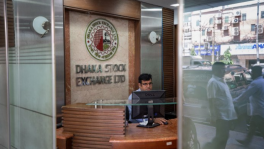As the middle class grows, so does the market for fancy rice
As people become more health-conscious and experiment with different types of cuisines, the demand for premium qualities of rice is growing, allowing some local rice variants to mount a comeback
Rokeya Akhter (pseudonym), is expecting a baby next April, but three months ago she was diagnosed with diabetes. As a result, her gynaecologist advised her to eat full-grain rice instead of white rice.
Initially the college teacher – stationed in Barishal – was confused about the availability of such types of rice at nearby shops. But to her surprise she found it shelved at one super shop in her vicinity. Rokeya is now a regular consumer of brown rice.
Khademul Islam, the owner of Kushtia Rice Agency shop in capital's Rampura area, used to sell Miniket and Najir Shail ( hybrid BRRI Dhan in actuality); and occasionally variants of aromatic rice. Due to customers' demand, he has been selling brown rice, besides the white ones, for the last year.
Habibur Rahman, a retired banker and one of the regular customers at Kushtia Rice Agency, said that he grew up eating full-grain rice. Later, the polished rice replaced the brownish grain. But now, he has started eating brown rice again following his physician's advice.

Coarse rice variety in the wholesale market is not rare. But the consumers of brown rice often search for the costly, slender versions. Why? Because rice-eaters were accustomed to the polished but slender Miniket. For them, the shape of the grain matters while some of them are now choosy about the flavour and taste each variety of rice has.
According to industry insiders, the rise of the middle class in the country has helped the premium rice market grow, even in the suburbs.
Noted chef Kalpana Rahman describes the trend as a change of view and tastes due to economic growth. According to her, cooking is no more a regular household chore, rather an art form.
She finds that people are trying different cuisines with ingredients available at the local market, irrespective of whether it is local or imported. Video tutorials available on YouTube on Asian and Arabian recipes are making people interested in multicultural food. Moreover, some agro-based companies manufacturing premium rice are marketing their products rather aggressively.
"Health-conscious people are picking up useful recipes from video tutorials and trying them out at home. As rice is our staple diet,when trying out new tastes we end up cooking rice-based food too. We know that different rice dishes require specific kinds of rice as key ingredients. So, the rice market is becoming diversified and the demand for the premium rice is growing," Kalpana told The Business Standard.

According to Bangladesh Rice Research Institute (BRRI), around 18,000 varieties of rice were cultivated in this geographical area even a century ago. Currently, only 3,000 varieties survive and only a few among them are cultivated commercially during the Boro and Aman seasons.
Full-grain or moderately husked Biroi, Topaboro, Rataboro, Binni and Lakha are among a few non-aromatic varieties and the aromatic Chinigura, Kalijeera, Katari Bhog, Tulshi Mala and Kartik Shail – all local breeds – constitute the premium rice market. Millers also produce aromatic BRRI Dhan 63 – a modified form of the Basmati variety of Punjabi-origin, at an industrial scale to lessen import dependency, as the demand for it is growing amid the popularity of Kacchi Biryani. Meanwhile, some farmers are cultivating an exotic variety of 'Black' rice for health-conscious consumers.
While the per kilogram retail price of the non-aromatic premium rice ranges from Tk70 to Tk200, the short-grain aromatic rice are sold at Tk125-Tk300 and the imported long-grain ones at Tk300-Tk350. Obviously, the prices of the premium products are higher than the regular options.

According to Bangladesh Bureau of Statistics, more than 22% of Bangladesh's population currently make up for the middle-class bracket. In 1992, the percentage was only 9. The expansion of the middle class in the country, where per capita consumption of rice is nearly the highest in Asia, not only shows a growing awareness about health but also creates a demand for rice diversity.
In 2007, when Naya Krishi Andolan had first brought the full-grain non-aromatic, as well as the local aromatic breeds, for commercial sale at Dhaka-based Sashya Prabartana outlet, people laughed at the organisers, presuming that the products will not attract any customers. But the growing demand for rice proves that these are not merely only for the wealthy now.
Naya Krishi Andolan co-organiser Farida Akhter said, "The situation has changed and now we fail to meet the demand often. Health experts even suggest [eating] rice. A message has been spread, even among middle-class people, that safe food ensures health. Cultivation of non-aromatic premium rice does not require toxic pesticides. Moreover, rice with full-grain is low on calories and rich with nutritional contents and antioxidants."
This correspondent talked to Subrata Basak, a business partner of the e-commerce platform Hoichoi based in Mymensingh. Hoichoi sources some local breeds of premium rice from Sherpur, Kishoreganj, Mymensingh and Cumilla and maintains a country-wide supply chain.

According to Subrata, the demand for full-grain rice increased at the outbreak of Coronavirus as people became more health-conscious. At present, the demand has fallen a little bit but the Hoichoi operators are still struggling to meet demands.
"Patients suffering from diabetes and heart diseases, parents of toddlers and health-conscious people are our regular customers," Subrata said, adding that every month, Hoichoi sells on an average 500 kilograms of non-aromatic premium rice.
Some northern districts, including Dinajpur, were once the major sources of aromatic rice. The production was minimal and confined to only the Aman season. The country was dependent mostly on imports from India, Pakistan, Egypt and Thailand for the products. Anticipating a growing demand, some business groups opened their agriculture wings and launched industrial production of aromatic rice, besides other items.
Badshah Bhog, Khaskhani, Bashful, Durbashail, Begun bichi, Kal Pakhri, Punia, Kamini, Jeerabhog, Chinishail, Sadagura, Madhumadhab, Gobindobhog, Dudhshail have been popular local breed aromatic rice, for ages. As the yields of the rice were not commercially remarkable, a few business corporations imported hybrid seed while BRRI released some 12 hybrid varieties including BRRI Dhan-34, 37, 38, 50 and 63; and Bangladesh Institute of Nuclear Agriculture (BINA) released BINA Dhan-9 and 13. Production of the hybrid varieties is two to three times higher than the indigenous breed.
The overall production of aromatic rice reached 1,775,178 tonnes in the 2020-21 fiscal year. Two fiscal years back, the amount was 766,305 tonnes, according to the Department of Agricultural Extension. Based on the growing harvests, at least 11 local brands including Pran, Radhuni, Chashi, Aarong, Pushti, Fresh and Aftab are thriving.
Kamruzzaman Kamal, director at Pran-RFL Group, said, "To make aromatic rice cultivation viable, Pran imported hybrid seeds and supported some northern district-based farmers under contractual farming. The initiative began in 1997. Since then, we procure the rice, pack the product and sell it. More farmers are showing an interest in farming this particular crop. The success is evident now. Many companies have taken up aromatic rice production on an industrial scale."
Yet, the imported premium rice varieties, particularly the long-grain Basmati, retains a strong position in the local market, claimed Mahbubul Alam, office in charge of S-Alam Trading International–one importer of foreign rice brands. The company imports around eight brands.
"You see the number of super shops is growing. Affluent shoppers of the particular zones seek premium rice from foreign brands. So we deal with a growing demand for the imported items," Mahbubul said. A random market survey found some foreign brands including Daawat, Qilla, Kaalar, Khusboo, Kohinoor, Lazzat and Royal (Thai) readily available in Bangladeshi supershops.


 Keep updated, follow The Business Standard's Google news channel
Keep updated, follow The Business Standard's Google news channel














